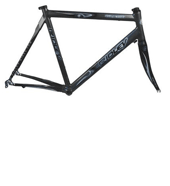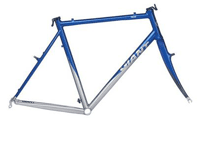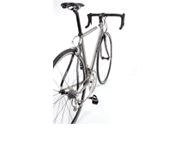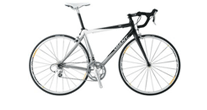Road Bike Frame Material
Most new road bikes are made of aluminium (or an aluminium alloy) or carbon. Titanium is a niche material, but is steadily growing in popularity. Here's a run down of your options: Carbon Fibre has to be the top choice for a racing bike. It is lightweight, extremely strong and affords the perfect compromise between comfort and performance. Carbon fibre is immensely strong in one direction, but rather fragile in terms of general transportation when compared to more traditional metal frames. The fluid nature of carbon has resulted in the 'monocoque' (one piece) frame - but not all monocoque frames are born equal! Some brands manufacture their own carbon to provide ultimate control over composition, strength and shape - this almost always results in a higher quality bike. Other manufacturers buy in carbon tubing and mold it together - resulting in a cheaper alternative, but of lower quality. Aluminium frames are stiff and hard wearing, but offer a slightly harsher ride than carbon frames. Newer alloys are constantly arriving on the market to tackle the comfort issue. Aluminium does not rust, providing a low maintenance frame. There are a range of different grades of aluminium; from basic alloys to high tech, light compounds. At the cutting edge of technology, this material is so advanced, some manufacturers still favour aluminium at the top end of their bike range, for example the Bianchi FG Lite. Titanium is the ultimate frame making material. It has all the best qualities found in the rest of the frame material market; lightweight, durable, extremely long lasting, rust-free and comfortable. Though titanium itself is relatively inexpensive, the cutting and welding process is difficult and still in its infancy, making titanium frames comparatively expensive. Steel is the traditional material for manufacturing bicycles and is currently regaining popularity due to its high level of comfort and classic, thin-tubed shape. Advances in coating techniques are overcoming previous corrosive shortcomings. Many niche materials still occupy Research and Development budgets in major manufacturers as the search for optimum strength, lightweight and durability continue. Magnesium is a good example of an up and coming niche material. It is estimated to be ten times as light and strong as aluminium, but difficult to manufacture and therefore expensive. Dual material bikes are a popular way of maximising the advantages and minimising the disadvantages of various materials. Manufacturers influence frames by adding other materials. For example, most aluminium bikes will come with a carbon rear end, adding comfort to the seat area. Other good examples include: Isaac Force; one of the stiffest carbon bikes on the market because of its aluminium seat stays. Lemond frames incorporate spine technology - the main spine of the bike is made of steel to offer the forgiving ride of a steel bike but with a carbon top tube, seat tube and seat stay. This reduces the weight and ensures that no energy is wasted through flexing; a typical drawback of a standard steel cycle. Carbon is usually added sequentially as follows: seat stays, chain stays, seat post, handlebars and stems. For carbon junkies, extra components include: bottle cages, seats, cranks, groupsets, and front mech and brake levers.
Many road bike frame manufacturers are characterised by their innovative frame shapes and styling. All are intended to change the performance of the bicycle in some way. Here's a run down of the most common options and the advantages and disadvantages.

- Oversized head tubes improve handling and control, steer more precisely and behave in a more predictable way. Example: Isaac frames.

- Curved seat stays work on the basis that two curves are better than one. They retain the rigidity of the rear triangle without losing the vertical compliance. The curves also afford more comfort and help smooth out road vibrations. Example: Pinarello F4:13 with Onda forks and seat stay.

- Oversized tubes (top, down and seat) exploit the principle that the further the tube wall from the tube axis, the less material is required to achieve the same strength. Example: [De Rosa Bikes]

- A sloping top tube results in less material for any given size of frame and also increases efficiency by making the tubes shorter (and therefore less likely to flex). Compact frames achieved through sloping top tubes are also more aerodynamic and benefit from a highly comfortable ride due to the increased seat post length. Examples: Giant TCR, or semi compact geometry e.g. Bianchi, Colnago, Ridley, Litespeed.

- Bikes with a traditional frame geometry comprising a horizontal top tube are still available and can provide a more comfortable ride in particular circumstances. Some manufacturers have influenced the tube wall thickness and shape to gain the benefits of compact geometries without the distinctive look. Example: Merlin.
Most new road bikes are made of aluminium (or an aluminium alloy) or carbon. Titanium is a niche material, but is steadily growing in popularity. Here's a run down of your options:

Carbon Fibre has to be the top choice for a racing bike. It is lightweight, extremely strong and affords the perfect compromise between comfort and performance. Carbon fibre is immensely strong in one direction, but rather fragile in terms of general transportation when compared to more traditional metal frames. The fluid nature of carbon has resulted in the 'monocoque' (one piece) frame - but not all monocoque frames are born equal! Some brands manufacture their own carbon to provide ultimate control over composition, strength and shape - this almost always results in a higher quality bike. Other manufacturers buy in carbon tubing and mold it together - resulting in a cheaper alternative, but of lower quality.

Aluminium frames are stiff and hard wearing, but offer a slightly harsher ride than carbon frames. Newer alloys are constantly arriving on the market to tackle the comfort issue. Aluminium does not rust, providing a low maintenance frame. There are a range of different grades of aluminium; from basic alloys to high tech, light compounds. At the cutting edge of technology, this material is so advanced, some manufacturers still favour aluminium at the top end of their bike range, for example the Bianchi FG Lite.

Titanium is the ultimate frame making material. It has all the best qualities found in the rest of the frame material market; lightweight, durable, extremely long lasting, rust-free and comfortable. Though titanium itself is relatively inexpensive, the cutting and welding process is difficult and still in its infancy, making titanium frames comparatively expensive.
Steel is the traditional material for manufacturing bicycles and is currently regaining popularity due to its high level of comfort and classic, thin-tubed shape. Advances in coating techniques are overcoming previous corrosive shortcomings.
Many niche materials still occupy Research and Development budgets in major manufacturers as the search for optimum strength, lightweight and durability continue. Magnesium is a good example of an up and coming niche material. It is estimated to be ten times as light and strong as aluminium, but difficult to manufacture and therefore expensive.

Dual material bikes are a popular way of maximising the advantages and minimising the disadvantages of various materials. Manufacturers influence frames by adding other materials. For example, most aluminium bikes will come with a carbon rear end, adding comfort to the seat area. Other good examples include:
- Isaac Force; one of the stiffest carbon bikes on the market because of its aluminium seat stays.
- Lemond frames incorporate spine technology - the main spine of the bike is made of steel to offer the forgiving ride of a steel bike but with a carbon top tube, seat tube and seat stay. This reduces the weight and ensures that no energy is wasted through flexing; a typical drawback of a standard steel cycle.
- Carbon is usually added sequentially as follows: seat stays, chain stays, seat post, handlebars and stems.
- For carbon junkies, extra components include: bottle cages, seats, cranks, groupsets, and front mech and brake levers.

